Matter of Faith
One of the central questions plaguing the cult of saints since its inception is how can the remains of holy men and women act as agents of God? After all, one is entirely material and thereby earth-bound, while the other is spiritual and can be manifest only in heaven.
Read more »
The twelfth-century theologian, Thiofrid of Echternacht, addressed this paradox with another vexing problem, namely how the bread and wine of the Eucharist become the body and blood of Christ. What makes Thiofrid's tract so remarkable is that he saw the Eucharist bread and wine, as well as the gold and precious jewels of reliquaries, as a necessary ruse, designed to help the faithful to stomach what they were consuming.
Certainly the materials used to protect and display the remains of the saints had a great deal to do with the perception of their power. Not only were precious metals considered to be incorruptible, just like the flesh of all those who lived an holy life, but also the gems that covered reliquaries were believed to contain magical properties akin to the bodies contained within.
This is not to say that there was always a one-to-one correlation between the exterior and the interior of a reliquary. Most reliquaries produced in the Middle Ages exhibit a marked disjunction between form and function, as in the case of the reliquary chasses produced in Cologne and Limoges during the twelfth century. Here the decorative enameling on the exterior usually depicts a compelling Christian story, rather than one related to the saint in question. A similar situation exists with the body-part reliquaries that became popular beginning in the eleventh and twelfth centuries. These reliquaries did not necessarily contain the remnants of an arm or a foot, but instead served as props for enacting the liturgy
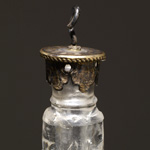 Fatimid Flask Reliquary
The modest dimensions of this Fatimid rock crystal vessel suggest that it was probably crafted originally as a perfume flask. At some point in the fourteenth century, it was converted to use as a Christian reliquary.
Fatimid Flask Reliquary
The modest dimensions of this Fatimid rock crystal vessel suggest that it was probably crafted originally as a perfume flask. At some point in the fourteenth century, it was converted to use as a Christian reliquary.
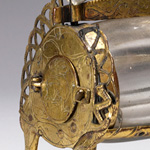 Crystal Reliquary
This barrel-shaped reliquary consists of a large, cylindrical piece of crystal bored down the middle to create a narrow compartment for a relic.
Crystal Reliquary
This barrel-shaped reliquary consists of a large, cylindrical piece of crystal bored down the middle to create a narrow compartment for a relic.
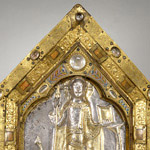 Reliquary from the Shrine of St. Oda
Like many surviving works of medieval art, these gable-shaped reliquaries are the product of a number of medieval and modern alterations.
Reliquary from the Shrine of St. Oda
Like many surviving works of medieval art, these gable-shaped reliquaries are the product of a number of medieval and modern alterations.
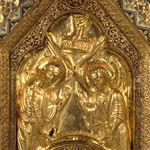 Reliquary of St. Gondulph
These gable reliquaries are part of a set of four, which until 1811 were placed on each side of the chasse of St. Servais in the saint's eponymous church in Maastricht.
Reliquary of St. Gondulph
These gable reliquaries are part of a set of four, which until 1811 were placed on each side of the chasse of St. Servais in the saint's eponymous church in Maastricht.
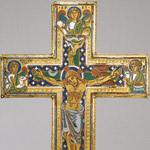 Reliquary of the True Cross
Purported fragments of the True Cross were brought to western Europe from the Holy Land and the Byzantine Empire throughout the Middle Ages, and their popularity appears to have increased with the greater contact between these regions during the Crusades.
Reliquary of the True Cross
Purported fragments of the True Cross were brought to western Europe from the Holy Land and the Byzantine Empire throughout the Middle Ages, and their popularity appears to have increased with the greater contact between these regions during the Crusades.
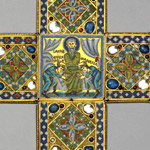 Reliquary Cross
These objects constitute the long-separated front and back of a Mosan cross reliquary.
Reliquary Cross
These objects constitute the long-separated front and back of a Mosan cross reliquary.
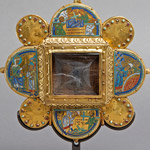 Phylactery
The narrative panels on the front potentially suggest the nature of the relic once contained by the phylactery and depict the discovery of the True Cross by the empress Helena.
Phylactery
The narrative panels on the front potentially suggest the nature of the relic once contained by the phylactery and depict the discovery of the True Cross by the empress Helena.
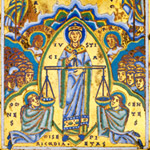 Triptych Reliquary of the True Cross
The triptych's elaborate iconographic program is intimately tied to the relic of the True Cross—and possibly other relics of Christ's Passion—once displayed behind rock crystal in the cavity at its center.
Triptych Reliquary of the True Cross
The triptych's elaborate iconographic program is intimately tied to the relic of the True Cross—and possibly other relics of Christ's Passion—once displayed behind rock crystal in the cavity at its center.
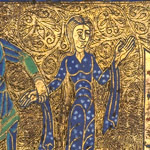 Reliquary Chasse with St. Valerie
The scenes on the front and lid of this chasse are episodes from the martyrdom of St. Valerie, the patron saint of Limoges.
Reliquary Chasse with St. Valerie
The scenes on the front and lid of this chasse are episodes from the martyrdom of St. Valerie, the patron saint of Limoges.
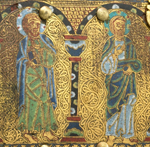 Reliquary Chasse with the Virgin and Child
We do not know what this casket once held, but the large image of the Virgin and Child that dominates the front of the chasse may hint at the type of relics it contained.
Reliquary Chasse with the Virgin and Child
We do not know what this casket once held, but the large image of the Virgin and Child that dominates the front of the chasse may hint at the type of relics it contained.
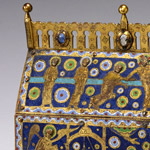 Reliquary Chasse with the Holy Women at the Tomb
Scholars have linked this object with several saints, including St. Martial, the first bishop of Limoges.
Reliquary Chasse with the Holy Women at the Tomb
Scholars have linked this object with several saints, including St. Martial, the first bishop of Limoges.
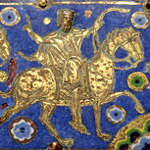 Reliquary Chasse with the Adoration of the Magi
Depictions of the three Wise Men are found on a number of Limoges caskets, ranking with St. Thomas Becket and St. Valerie among the most popular subjects.
Reliquary Chasse with the Adoration of the Magi
Depictions of the three Wise Men are found on a number of Limoges caskets, ranking with St. Thomas Becket and St. Valerie among the most popular subjects.
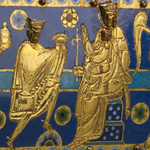 Reliquary Chasse with the Adoration of the Magi
In addition to their role as historical witnesses to the Nativity, the three Magi are symbolically important to Christian doctrine: they are icons of true faith and belief in the divinity of Christ.
Reliquary Chasse with the Adoration of the Magi
In addition to their role as historical witnesses to the Nativity, the three Magi are symbolically important to Christian doctrine: they are icons of true faith and belief in the divinity of Christ.
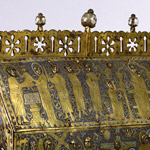 Reliquary Chasse with Scenes from the Life of Christ
The front of the casket features several scenes from the life of Christ: along the top are the Presentation in the Temple, the Adoration of the Magi, and the Flight into Egypt, and on the lower panel, Christ carrying the Cross, the Crucifixion, and the Holy Women at the Tomb.
Reliquary Chasse with Scenes from the Life of Christ
The front of the casket features several scenes from the life of Christ: along the top are the Presentation in the Temple, the Adoration of the Magi, and the Flight into Egypt, and on the lower panel, Christ carrying the Cross, the Crucifixion, and the Holy Women at the Tomb.
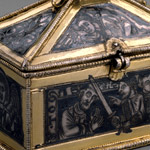 Reliquary Chasse with Scenes of the Martyrdom of Thomas Becket
This is undoubtedly one of the earliest reliquaries associated with the sainted archbishop of Canterbury; its dramatic use of niello lends a cold, graphic immediacy to the scenes.
Reliquary Chasse with Scenes of the Martyrdom of Thomas Becket
This is undoubtedly one of the earliest reliquaries associated with the sainted archbishop of Canterbury; its dramatic use of niello lends a cold, graphic immediacy to the scenes.
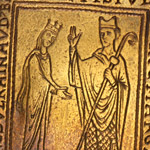 Reliquary Pendant with Queen Margaret of Sicily and Bishop Reginald of Bath
Reginald Fitz-Jocelyn, who was consecrated as bishop of Bath in 1174, presented this pendant to Margaret of Navarre, queen of Sicily.
Reliquary Pendant with Queen Margaret of Sicily and Bishop Reginald of Bath
Reginald Fitz-Jocelyn, who was consecrated as bishop of Bath in 1174, presented this pendant to Margaret of Navarre, queen of Sicily.
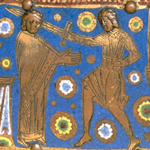 Reliquary Chasse with Scenes of the Martyrdom of Thomas Becket
A very similar chasse is in the Musée du Louvre, Paris. The front panels of both show the scene of Becket's murder: as he stands by an altar his neck is struck by the sword of one of two knights who advance upon him.
Reliquary Chasse with Scenes of the Martyrdom of Thomas Becket
A very similar chasse is in the Musée du Louvre, Paris. The front panels of both show the scene of Becket's murder: as he stands by an altar his neck is struck by the sword of one of two knights who advance upon him.
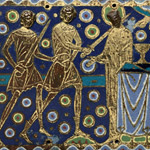 Plaque from a Reliquary Chasse
While chasses decorated with scenes of the martyrdom of Thomas Becket are likely to have contained relics of the saint, their actual relic content rarely survives.
Plaque from a Reliquary Chasse
While chasses decorated with scenes of the martyrdom of Thomas Becket are likely to have contained relics of the saint, their actual relic content rarely survives.
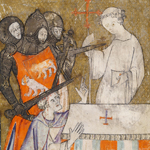 The Butler Hours
Books of Hours were personal prayer books made for the laity, based on the daily prayer cycles or "hours" observed by monks.
The Butler Hours
Books of Hours were personal prayer books made for the laity, based on the daily prayer cycles or "hours" observed by monks.
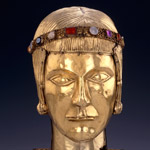 Reliquary Head of St. Eustace
This head reliquary has been associated since 1477 with St. Eustace, a Roman general who, having seen a stag with an image of the Crucifixion between its antlers, converted to Christianity and was martyred for his faith.
Reliquary Head of St. Eustace
This head reliquary has been associated since 1477 with St. Eustace, a Roman general who, having seen a stag with an image of the Crucifixion between its antlers, converted to Christianity and was martyred for his faith.
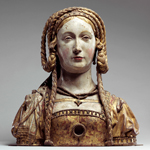 Reliquary Bust of St. Balbina
A hinged rectangular lid at the crown of the head of this reliquary opens to expose the relics of a skull still nestled tightly inside.
Reliquary Bust of St. Balbina
A hinged rectangular lid at the crown of the head of this reliquary opens to expose the relics of a skull still nestled tightly inside.
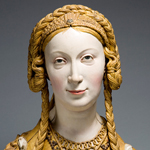 Reliquary Bust of an Unknown Female Saint, Probably a Companion of St. Ursula
By the late Middle Ages, bust reliquaries for the skulls of saints were often assembled in large numbers in church sanctuaries. This was especially the case with reliquaries of the companions of St. Ursula, legendarily reputed to number 11,000.
Reliquary Bust of an Unknown Female Saint, Probably a Companion of St. Ursula
By the late Middle Ages, bust reliquaries for the skulls of saints were often assembled in large numbers in church sanctuaries. This was especially the case with reliquaries of the companions of St. Ursula, legendarily reputed to number 11,000.
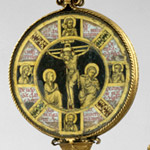 Reliquary of the Tooth of Mary Magdalene
Over the course of the Middle Ages, the Magdalene became a highly venerated saint. Her relics were particularly venerated in France: at Vézelay, reputedly as early as the eighth century, and in Provence from the late thirteenth century.
Reliquary of the Tooth of Mary Magdalene
Over the course of the Middle Ages, the Magdalene became a highly venerated saint. Her relics were particularly venerated in France: at Vézelay, reputedly as early as the eighth century, and in Provence from the late thirteenth century.
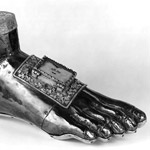 Reliquary of the Foot of St. Blaise
Reliquaries shaped to "speak" their contents, such as this foot reliquary, often contained the relics of multiple saints.
Reliquary of the Foot of St. Blaise
Reliquaries shaped to "speak" their contents, such as this foot reliquary, often contained the relics of multiple saints.
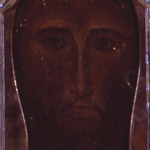 Mandylion
The elaborate seventeenth-century mount that frames and crowns the likeness of Christ's face provides a brilliant contrast for the dark, almost invisible portrait and, simultaneously, establishes its aspect as a relic within a reliquary.
Mandylion
The elaborate seventeenth-century mount that frames and crowns the likeness of Christ's face provides a brilliant contrast for the dark, almost invisible portrait and, simultaneously, establishes its aspect as a relic within a reliquary.
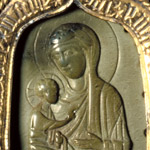 Pendant Icon with the Virgin Dexiokratousa
This small pendant belonged to the treasury of Aachen Cathedral until 1804, when it was given to Empress Joséphine of France as a gift.
Pendant Icon with the Virgin Dexiokratousa
This small pendant belonged to the treasury of Aachen Cathedral until 1804, when it was given to Empress Joséphine of France as a gift.
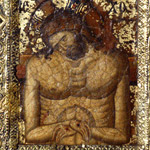 Imago pietatis (Man of Sorrows)
A precious icon of the Man of Sorrows made of minute stones in Byzantium at the end of the thirteenth century or the beginning of the fourteenth was treated as a relic only after it was brought to Rome around 1380.
Imago pietatis (Man of Sorrows)
A precious icon of the Man of Sorrows made of minute stones in Byzantium at the end of the thirteenth century or the beginning of the fourteenth was treated as a relic only after it was brought to Rome around 1380.
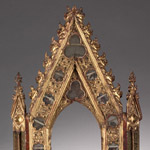 Reliquary Frame
Detachable from its base, the upper part could have been mounted on a pole and carried aloft in processions. Otherwise, the object likely resided upon the altar of a small chapel.
Reliquary Frame
Detachable from its base, the upper part could have been mounted on a pole and carried aloft in processions. Otherwise, the object likely resided upon the altar of a small chapel.
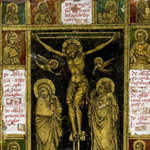 Wing of a Reliquary Diptych with the Crucifixion and Saints
This work, probably the right wing of a diptych, brings together an unusual range of media, combining painted surfaces with inset plaques of verre églomisé as well as inlaid fragments of marble and ceramic.
Wing of a Reliquary Diptych with the Crucifixion and Saints
This work, probably the right wing of a diptych, brings together an unusual range of media, combining painted surfaces with inset plaques of verre églomisé as well as inlaid fragments of marble and ceramic.
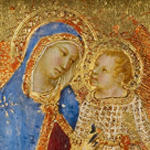 Reliquary with Madonna and Child with Saints
This triptych is both a painting and a reliquary; it once contained relics in the circular holes of the central section.
Reliquary with Madonna and Child with Saints
This triptych is both a painting and a reliquary; it once contained relics in the circular holes of the central section.
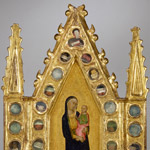 Reliquary Tabernacle with Virgin and Child
Naddo Ceccarelli, a talented follower of Simone Martini (ca. 1284–1344), was one of a handful of Sienese painters to create reliquaries that emulated the work produced by goldsmiths.
Reliquary Tabernacle with Virgin and Child
Naddo Ceccarelli, a talented follower of Simone Martini (ca. 1284–1344), was one of a handful of Sienese painters to create reliquaries that emulated the work produced by goldsmiths.
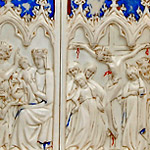 Reliquary Triptych with the Annunciation, St. Ansanus, the Adoration of the Magi, and the Crucifixion
Although related to a devotional format established by the mid-fourteenth century, this winged tabernacle uniquely incorporates an ivory diptych into its central panel.
Reliquary Triptych with the Annunciation, St. Ansanus, the Adoration of the Magi, and the Crucifixion
Although related to a devotional format established by the mid-fourteenth century, this winged tabernacle uniquely incorporates an ivory diptych into its central panel.
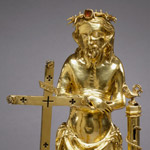 Reliquary with the Man of Sorrows
The image of the Man of Sorrows is a distillation of the events of Christ's Passion.
Reliquary with the Man of Sorrows
The image of the Man of Sorrows is a distillation of the events of Christ's Passion.








































